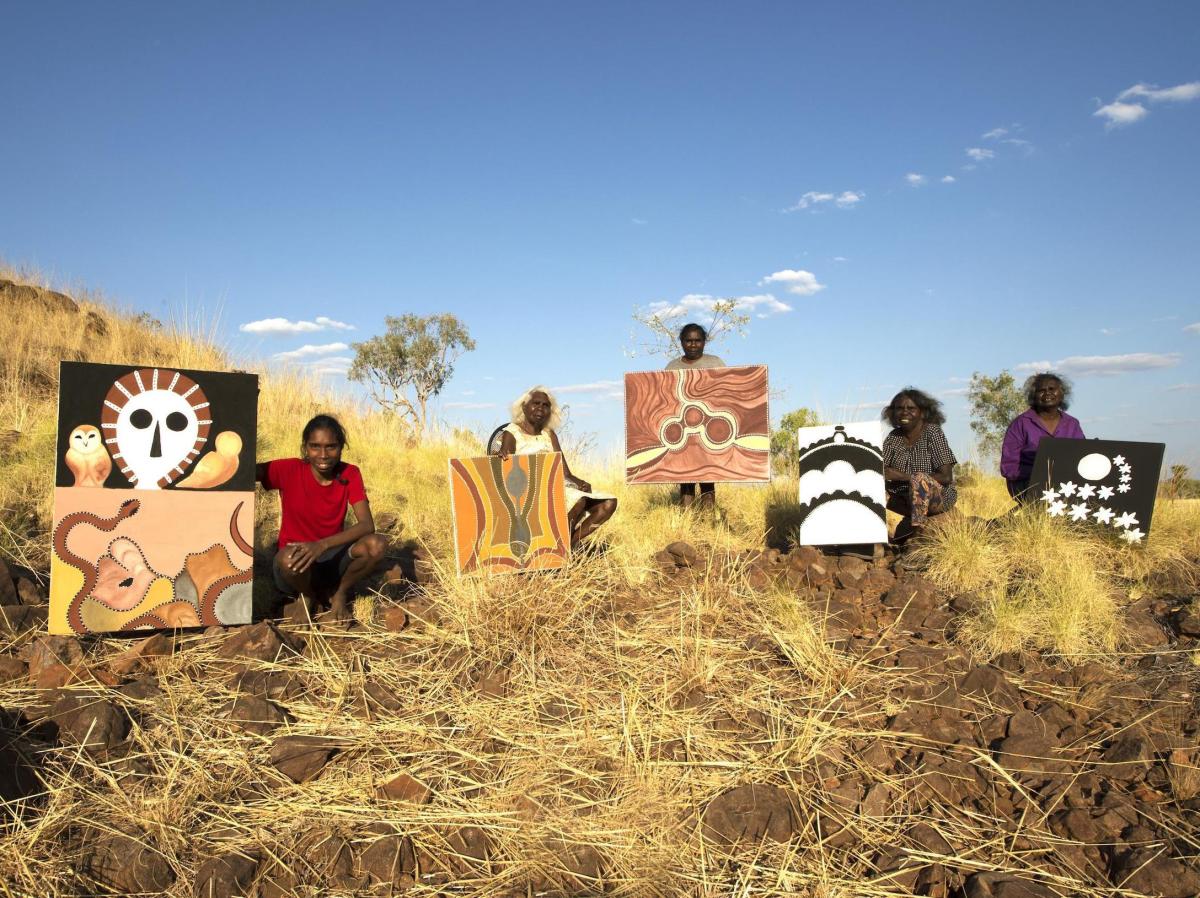Four generations of Warmun women artists support the Indigenous Art Code and ethical trade in Indigenous Arts. From left to right: April Nulgit, Betty Carrington, Charlene Carrington, Sadie Carrington and Bessie Daylight. Image: Darren Clark – Warmun Art Centre.
While many Aboriginal and Torres Strait Islander visual artists enjoy profitable and congenial relationships with dealers who sell their works, it’s not the case for all.
In 2009 the national Indigenous Art Code (IartC) was established to prevent exploitation by promoting best practice conduct for the the commercial relationship between dealers and artists, particularly those who work independently of Aboriginal and Torres Strait Islander-owned and managed art centres.
And, while the behaviour that triggered the need for the IartC to be established is no longer as severe as it once was, sadly there are still many instances where Aboriginal and Torres Strait Islander artists are being taken advantage of, said IartC CEO Gabrielle Sullivan.
‘If you are an independent artist working on your own, you need to navigate that transactional space by yourself, and that can be hard,’ she said.
‘Unfortunately there are some art dealers who exploit that vulnerable position.’
A common issue for artists is dealers who will pay them a small fee for an artwork, and then sell it at highly inflated prices a few weeks later. Often artists are reluctant to report bad behaviour for fear of losing income from a dealer who might shun them for doing so.
‘What the Code is trying to deal with in that space is ethics and morals,’ said Sullivan. ‘It is legal to pay $500 for an artwork and sell it a couple of weeks later for $5000 but that doesn’t make it fair. The Code doesn’t want to be scaremongers, there are a lot of great dealers out there, but artists need to be able to make informed decisions and we can’t pretend that poor conduct doesn’t exist.’
The Code has three levels of membership: Aboriginal and Torres Strait Islander artists who can join for free; dealer members which are businesses that sell and license art who pay a $168 annual fee; and supporters who are either organisations or individuals who aren’t in the trade but support the IartC and also pay the $168 fee.
Dealer members who become signatories are expected to abide by the Code, and 18 months ago the IartC revised the application questionnaire dealers were given so the organisation is more aware of how each business works and how owners approach things such as copyright and Indigenous cultural intellectual property. Sullivan said she has noticed a positive shift as a result.
‘A lot of people are not trying to do the wrong thing but some of these issues are complex and people required guidance and advice’, she said
‘It does mean more conversations with dealers about valuing and respecting the artists rights and in turn artists understanding the role of the dealer in the promotion and selling of their work.
‘A fair and ethical market requires transparency, and this means open dialogue between artists and dealers, a fair dealer will be completely transparent with artists and consumers about their supply chains and how they work with artists. It has definitely meant people are engaging with the Code and signing up to be a member.’
She said the recent ‘fake art’ campaign has raised even more awareness of IartC and made it more accessible to artists, because the word ‘fake’ has broader meaning than just the artwork being flogged to tourists.
‘I think that issue around the fake art is very important to every Aboriginal and Torres Strait Islander artist that I speak to,’ she said. ‘That word was meaningful to a lot of people. And not just fake art but fake deals or rubbish deals.’
The IartC serves a multitude of purposes. Although a voluntary code of conduct, it sets a high standard of professionalism for art traders to adhere to. Through hands-on work, the IartC also acts as a support for artists who need assistance and support, and it also acts as a referral service, where artists who may require more specialised advice will be referred to ArtsLaw, the Copyright Agency or National Association for the Visual Arts (NAVA).
The IartC is also increasingly focused on educating consumers about the code and encouraging buyers of art to support dealer members over others, and to ask dealers detailed questions about the origins of a piece, how an artist was paid and even how much they were paid.
By far the most profound effect, according to Bindi Cole Chocka, an artist and Director on the IartC board, is its future ramifications.
‘The Code is calling the arts industry to account,’ she said. ‘It’s much like the fashion industry where we now understand so much more about unethical trading when it comes to the manufacture of clothing and also the coffee industry where we understand about unethical trading.
‘What the Code is doing is similar to this. And every single Aboriginal and Torres Strait Islander artist in the country will be impacted by the legacy that the Code leaves for everybody from grassroots to major commercial artists in terms of best practice.’
Both Sullivan and Cole Chocka hope that wider education about IartC will encourage artists who feel powerless to step up and ask for help.
Find out more about the Indigenous Art Code at indigenousartcode.org.





